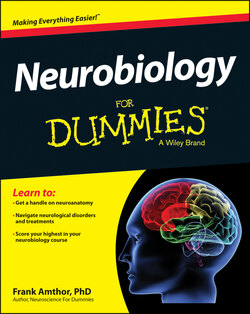Читать книгу Neurobiology For Dummies - Frank Amthor - Страница 68
Cytoplasm and organelles
ОглавлениеWithin the neuronal cytoplasm are typical eukaryotic organelles (or, plainly, parts of the cell). The following organelles reside in the cytoplasm:
Mitochondria: These are self-replicating organelles that generate adenosine triphosphate (ATP), the cell’s main energy source. ATP is generated by a process called oxidative phosphorylation, in which energy from electron transfer involving oxygen adds a phosphate to adenosine diphosphate (ADP). Mitochondria have their own DNA and multiply by cell division on their own, as needed for the cell’s energy requirements. Neurons have very high concentrations of mitochondria compared to other cells.
Endoplasmic reticulum (ER): The ER is an organelle composed of flattened tubes (cisternae) involved in protein synthesis, and carbohydrate and lipid metabolism, among other functions. ER has two forms: rough and smooth. Rough ER contains ribosomes where mRNA is used to synthesize proteins from amino acids. Smooth ER synthesizes steroids, phospholipids, and other lipids. One of its functions in neurons is the modification of cell membrane proteins that will become receptors. It also regulates (sequesters) calcium ion concentration.
Golgi apparatus: This organelle processes proteins and lipids that are synthesized by the cell. This is also where peptide neurotransmitters may be packaged into vesicles that are suitable to release outside the cell.
Lysosomes and peroxisomes: These two organelles use enzymes to digest viruses or bacteria that have entered the cell, and non-functioning organelles. Peroxisomes use enzymes to degrade toxic peroxides.
Centrosome: The centrosome is a cytoskeletal organizer. It consists of two centrioles (cylinder-shaped cell structures) that separate during cell division to form the mitotic spindle. Centrosomes are organizing centers for microtubules, which make up a large portion of the overall cytoskeleton. Microtubules are particularly important in extended neural processes such as dendrites and axons. The centrosome also controls transport of proteins through the Golgi apparatus and ER.
